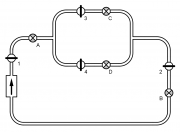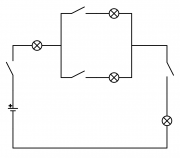*: Unterschied zwischen den Versionen
Aus Schulphysikwiki
| Zeile 3: | Zeile 3: | ||
|height="1100px"| | |height="1100px"| | ||
|} | |} | ||
| − | == | + | ==Das Modell des Wasserstromkreises== |
| − | + | ||
| − | + | ||
| − | + | ||
| − | + | ||
{|class="wikitable" | {|class="wikitable" | ||
| − | !style="border-style: solid; border-width: 2px | + | |[[Bild:Wasserstromkreis_als_Modell.png|180px]] |
| + | |[[Bild:Wasserstromkreis als Modell elektrischer Schaltplan.png|180px]] | ||
| + | |- | ||
| + | !style="border-style: solid; border-width: 2px "| | ||
Wasserstromkreis | Wasserstromkreis | ||
| − | !style="border-style: solid; border-width: 2px | + | !style="border-style: solid; border-width: 2px "| |
elektrischer Stromkreis | elektrischer Stromkreis | ||
|- | |- | ||
|style="border-style: solid; border-width: 2px "| | |style="border-style: solid; border-width: 2px "| | ||
| − | Wasser | + | Das Wasser fließt im Kreis durch die Schläuche. |
|style="border-style: solid; border-width: 2px "| | |style="border-style: solid; border-width: 2px "| | ||
| − | + | Die elektrische Ladung ("Elektrizität") fließt im Kreis durch die Kabel. | |
|- | |- | ||
|style="border-style: solid; border-width: 2px "| | |style="border-style: solid; border-width: 2px "| | ||
| − | Pumpe | + | Die Pumpe treibt das Wasser an. |
|style="border-style: solid; border-width: 2px "| | |style="border-style: solid; border-width: 2px "| | ||
| − | + | Die Batterie (das Netzgerät, der Dynamo, der Generator) treibt die elektrische Ladung an. | |
|- | |- | ||
|style="border-style: solid; border-width: 2px "| | |style="border-style: solid; border-width: 2px "| | ||
| − | + | Das fließende Wasser treibt das Rädchen an. | |
|style="border-style: solid; border-width: 2px "| | |style="border-style: solid; border-width: 2px "| | ||
| − | + | Die fließende elektrische Ladung ("der Strom") läßt die Lämpchen leuchten. | |
|- | |- | ||
|style="border-style: solid; border-width: 2px "| | |style="border-style: solid; border-width: 2px "| | ||
| − | + | Die Energie kommt von der Pumpe und wird vom Wasser zum Rädchen transportiert. | |
|style="border-style: solid; border-width: 2px "| | |style="border-style: solid; border-width: 2px "| | ||
| + | Die Energie kommt aus der Batterie und wird von der elektrischen Ladung zur Lampe transportiert. | ||
|- | |- | ||
|style="border-style: solid; border-width: 2px "| | |style="border-style: solid; border-width: 2px "| | ||
| − | + | Der Wasserhahn unterbricht den Wasserfluß. | |
|style="border-style: solid; border-width: 2px "| | |style="border-style: solid; border-width: 2px "| | ||
| − | + | Der Schalter unterbricht und schließt den elektrischen Stromkreis. | |
|- | |- | ||
| + | |style="border-style: solid; border-width: 2px "| | ||
| + | Nur wenn das Wasser im Kreis fließen kann, dreht sich ein Rädchen. | ||
| + | |style="border-style: solid; border-width: 2px "| | ||
| + | Nur bei geschlossenem Stromkreis leuchtet die Lampe. | ||
| + | |- | ||
| + | |style="border-style: solid; border-width: 2px "| | ||
| + | Die Wassermenge wird in Litern angegeben. | ||
| + | |style="border-style: solid; border-width: 2px "| | ||
| + | Die Menge der elektrischen Ladung ("Elektrizität") wird in Coulomb (<math>C</math>) angegeben. | ||
| + | |- | ||
| + | |style="border-style: solid; border-width: 2px "| | ||
| + | Die Wasserstromstärke wird in Litern pro Sekunde angegeben. | ||
| + | |style="border-style: solid; border-width: 2px "| | ||
| + | Die elektrische Stromstärke wird in Coulomb pro Sekunde angegeben. Das ist ein Ampère | ||
| + | :<math>1\,\rm A = \rm \frac{1\,C}{1\,s}</math> | ||
|} | |} | ||
| − | |||
| − | |||
| − | |||
| − | |||
| − | |||
| − | |||
| − | |||
| − | |||
| − | |||
| − | |||
| − | |||
| − | |||
| − | |||
| − | |||
| − | |||
| − | |||
| − | |||
| − | |||
| − | |||
| − | |||
| − | |||
| − | |||
| − | |||
| − | |||
| − | |||
| − | |||
| − | |||
| − | |||
| − | |||
| − | |||
| − | |||
| − | |||
| − | |||
| − | |||
| − | |||
| − | |||

